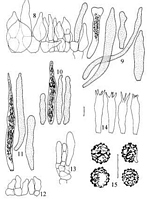|
 Russula pleurogena Russula pleurogena
BiostatusPresent in region - Indigenous. Endemic
Images (click to enlarge)
Caption: FIGS. 8-15. Russula pleurogena (HOLOTYPE). 8. Extremities of the pileipellis. 9.
Pileocysbdia. 10. Cheilomacrocystidia. 11. Pleuromacrocystidia. 12. Marginal cells. 13.
Detail of hymenium and subhymenium. 14. Basidia. 15. Spores as observed in | 
Caption: FIG. 16. Russula pleurogena (HOLOTYPE). Basidiomata. Scale bar = 10 mm. |
Article: Buyck, B.; Horak, E. (1999). New taxa of pleurotoid Russulaceae. Mycologia 91(3): 532-537.
Description: Basidioma solitary. Pileus 4-26mm diam, circular to ear-shaped or conchate, convex to
expanded, nonstriate margin not incurved, fuscous to fuliginous, ± breaking up along
concentrical lines to expose off-white to grey subcuticular context, densely granulose or
minutely scurfy-scaly, dry. Veil remnants absent. Lamellae relatively distant, alternating
with 1 to 3 lamellulae, adnate, not emarginate, ventricose, at first white, turning to off-white and finally
pale ochre-beige, grey at base, even edges concolorous. Stipe 20-50 X
1.5-5 mm, eccentric to lateral, robust, cylindric or gradually attenuating towards base„
always well-developed, concolorous with lamellae, dry and whitish pruinose over entire
length, solid then hollow. Context extremely brittle, pale grey-brown, not blackening
upon bruising but exsiccata entirely dark greyish brown to black. Odor not distinctive.
Taste very acrid, burning. Latex absent. Exsiccatum entirely dark greyish brown to black,
extremely brittle. Spores subglobose to ellipsoid, 7.2-7.74-8.1 X 6.6-6.99-7.5 µm
(Q=1.07-1.11-1.18); ornamentation formed of large, blunt, strongly amyloid warts,
sometimes fused into short ridges, but mostly connected by subtle, sometimes hardly
visible tracti into an almost complete network; plage large, not amyloid. Basidia 36-45 X
9-10 µm, generally tetrasporic; sterigmata stout, 7-9(12) X 1.5-2 µm. Cystidia
moderately numerous (1100-1300/mm2) on sides of the lamellae, crowded on edge,
mostly originating in subhymenium, projecting up to 20-55 µm above the hymenium-level; contents
abundant, needle-like, distinctly blueing in SV. Marginal cells abundant,
very short, poorly differentiated or sometimes sublageniform. Subhymenium large-celled.
Larnellar trama almost exclusively composed of sphaerocytes. Pileipellis resting on a
loosely structured and very thin trama of voluminous sphaerocytes and short-celled,
distinctly incrusted, connective hyphae measuring 3-6 µm diam, orthochromatic in cresyl
blue, one-layered, composed of large, thin-walled cells. 8-15(32) µm diam, containing
diffuse brown pigment; pileocystidia numerous in the pellis and below, generally 40-100
X 7-10(15) µm, longer and more slender in trama, without septa, ± thin-walled, with
abundant crystalline contents, blueing in SV. Stipitipellis composed of similar elements
as the pileipellis, but more dispersed. Clamps absent in all parts.
Habitat: Habitat. On rotting trunk of Cyathea sp. (Dicksoniaceae, tree ferns) and occasionally also
on rotting wood in broad-leaved forest dominated by Leptospermum scoparium and
Kunzea ericoides (Myrtaceae) .
Notes: Commentary. The microscopic features of the hymenium and pileipellis of both Russula species are very similar not only to each other but also to those described and illustrated for some mild-tasting African species (Buyck 1993), in particular R diffusa Buyck, R. archaeofistulosa Buyck nom. prov. and R carbonaria R. Heim & Gilles.
Russula carbonaria, described from periodically flooded rain forest in Gabon (Heim 1971), has an exceptionally small pileus (< 26 mm diam) but is otherwise typical of species in sect. Compactae subsect. Nigricantes Bataille with reddening and then blackening context. It is only known from a single basidioma that constitutes the type-specimen (PC). In the herbarium, the charcoal-coloured basidioma of R. carbonaria would be difficult to distinguish from R. lateralipes if not for the central attachment of the (curved!) stipe. Russula carbonaria is nevertheless easily distinguished from both pleurotoid species described above under the microscope by the crested, Lactarius-like spores and the typical Nigricantes-pileocystidia (see Buyck 1993).
Russula archaeofistulosa, placed in subsect. Fistulosinae R. Heim ex Singer, was suggested to link sections Compactae and Fistulosae (R. Heim ex Singer) Buyck because of its microscopic features (Buyck 1989b, 1993). The description was based on an exsiccatum without fieldnotes and was, therefore, introduced as "nomen provisorum" (Buyck 1993). The exsiccatum shows several well-preserved, centrally stipitate basidiomata with a very small pileus (10-25 mm diarn). It does not turn black, has widely spaced lamellae and very few lamellulae. It grows on wood in the dense dry forests of southern Zaire.
Russula diffusa, a medium-sized species of sect. Fistulosae subsect. Meleagrinae Buyck, has the same striate margin and disrupting pileipellis. It differs microscopically from the pleurotoid Russula essentially by spore ornamentation (isolate verrucae).
Russula lateralipes shares with these African species the possession of a mild context, making the burning acrid taste of R. pleurogena somewhat unexpected because there are no important microscopic differences, However, taste appears to be a highly variable character in most of the `primitive' infrageneric taxa in Russula.
The best disposition of these pleurotoid species in the classification of the Russulaceae is somewhat problematic because they form part of a transformation series involving several other subsections and sections. To separate them into a new genus, as suggested by Redhead and Norvell (1993) for pleurotoid Lactarius, is unwarranted given the high similarity with other Russula species. The striation of the pileus margin and dry, tomentose-velutinous pellis which breaks up into smaller fragments towards the margin are features that clearly refer these taxa to Meleagrinae. We, therefore, propose to place both species in sect. Lateralipedes sect. nov. linked with sect. Fistulosae through subsect. Meleagrinae.
|